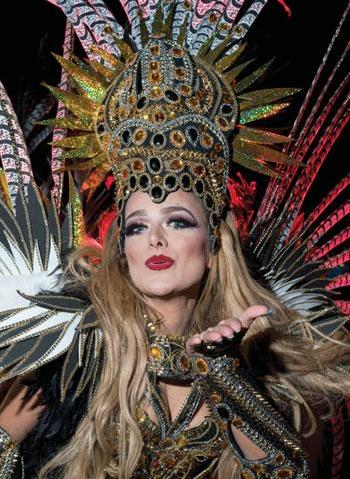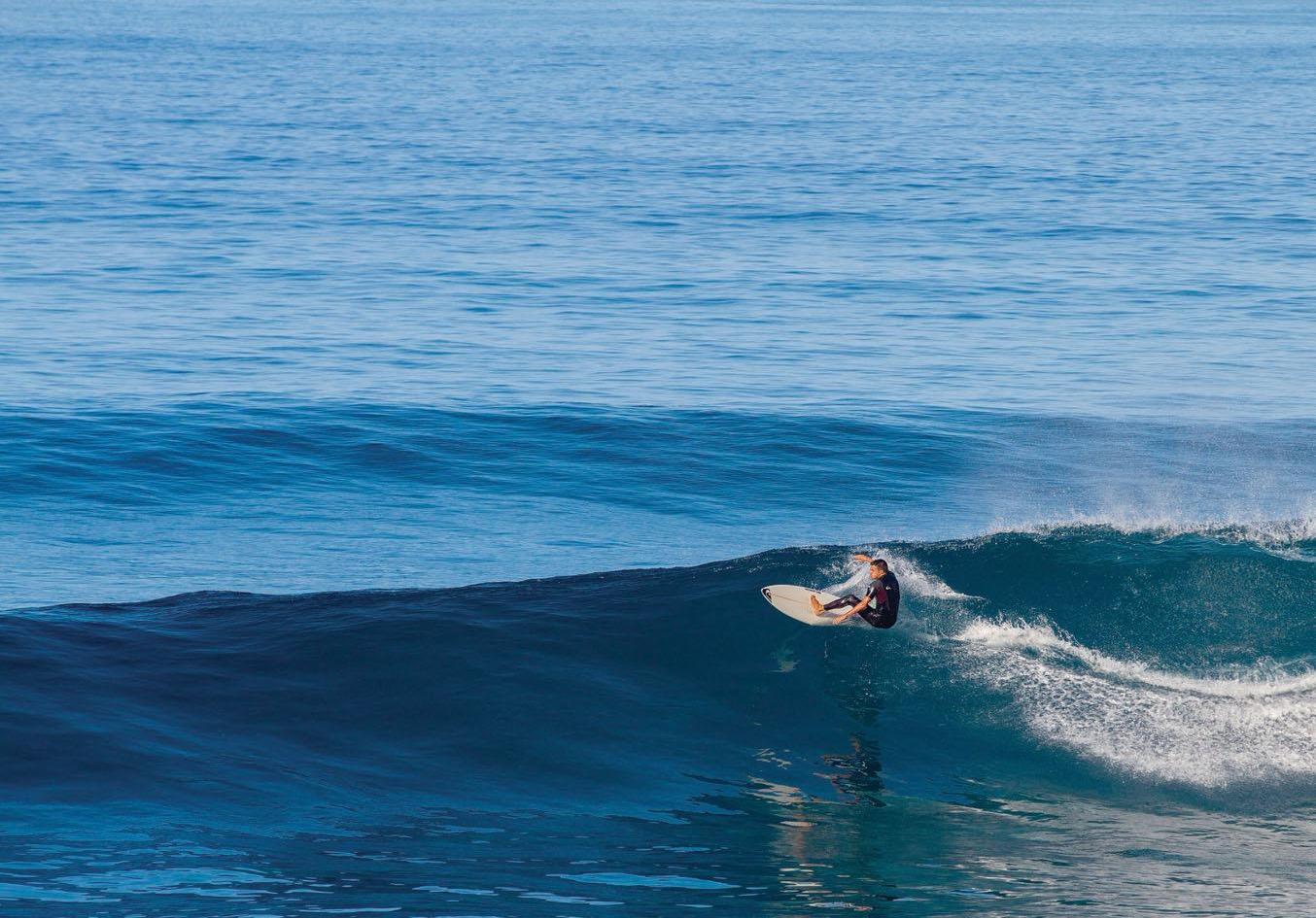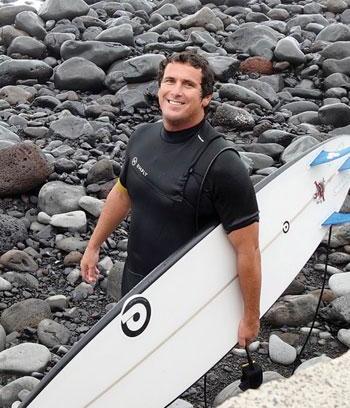
9 minute read
Heritage
The tradition of Carnival

Advertisement

Colour, rhythm and beauty… that is Carnival in Madeira Cor, ritmo, humor e beleza… assim é o Carnaval na Madeira
Around mid-February, occasionally early March, when our mild winter has yet to finish, Madeira starts to warm up to celebrate Carnival.
It is the first event in the yearly entertainment calendar of the tourist destination. Over the last few decades, there has been an increase in events and participants.
Carnival arrived in Madeira with the first European settlers in the 15th century. And in the 16th century the festivity went from here to Brazil where it became a world reference.
When, in 1980, the Madeira Tourism Board set the first parade to the tunes of samba, it was taking inspiration from Brazilian carnival, but also from the balls that used to breathe life into the hotels back then.
The Saturday evening parade featuring over a thousand participants and a dozen groups became a highlight. But there is also Cortejo Trapalhão, held on Shrove Tuesday and inspired by the more folkloric roots of Carnival, with improvised costumes, satire and humour.
Recently the Children's Carnival was created, in which children parade in the city streets.
Carnival in Madeira is a festivity which this year, was not able to hit the streets an effort to contain Covid-19. There are no paradesbut the tradition is still remembered througha set of videos and testimonies on digital media that were put together by the Regional Secretariat for Tourism and Culture.
It is a way to assert who we are and to ensure that we will be back!


SITE OFICIAL: WWW.VISITMADEIRA.PT FACEBOOK: HTTPS://WWW.FACEBOOK.COM/VISITMADEIRAOFFICIAL INSTAGRAM: HTTPS://WWW.INSTAGRAM.COM/VISITMADEIRA Em meados de fevereiro, às vezes início de março, quando o inverno, por aqui ameno, ainda não acabou, a Madeira aquece para celebrar o Carnaval.
É o primeiro evento do calendário anual de animação do destino turístico e nas últimas quatro décadas cresceu em eventos e participantes.
O Carnaval chegou à Madeira com os povoadores, vindo da Europa, no século XV. E daqui seguiu para o Brasil, no século XVI, onde se tornou referência mundial.
Quando em 1980 a Secretaria Regional de Turismo levou à rua o primeiro desfile ao ritmo do samba, estava a inspirar-se no carnaval brasileiro, mas também nos bailes que nesta época animavam os hotéis.
O grande cortejo na noite de sábado passou a ser um ponto alto com mais de um milhar de figurantes e cerca de uma dezena de grupos. Mas também se realiza na terça-feira o Cortejo Trapalhão, que se inspira no Carnaval mais popular, com disfarces improvisados, muita sátira e humor.
Mais recentemente foi criado o Carnaval das Crianças, com desfile pelas ruas da cidade.
O Carnaval na Madeira é uma festa, que este ano não saiu à rua associando-se à luta contra a Covid-19. Não há desfiles, mas a tradição é assinalada através de um conjunto de vídeos e testemunhos nas plataformas digitais, preparados pela Secretaria Regional do Turismo e Cultura.
É uma forma de lembrar quem somos e garantir que voltaremos!
The temple of surf
The mysticism surrounding surf has made Jardim do Mar into a site of pilgrimage for surf lovers
O misticismo à volta do surf tornou o Jardim do Mar num motivo de peregrinação para os amantes das ondas

Arudimentary beauty adorns the small houses and agricultural terrains of Jardim do Mar, a small parish in the municipality of Calheta.
A barren slope commands the respect that is owed nature in its purest state. It is, however, the strength of the waves that can reach heights of up to 15 metres that impresses upon residents and visitors alike.
It is that energy oozing from the Atlantic Ocean that makes Jardim do Mar one of Europe’s most acclaimed places for the practice of surf, to the point it is considered like a temple of sorts for this sport.
And some even go as far as making Jardim do Mar their home, at least for part of the year, so they can enjoy the serenity that the deep sea has to offer. That is the case of Mickael Hanchana, or Chino, as he like to be called.
Chino combines seasonal work with his passions and travels according to the seasons of the year searching for the best places to practice hiking, snowboard, mountain biking and, of course, surf. In Jardim do Mar he found the ideal place where he can ride the waves.
There, ‘one learns a lot about oneself and that is what makes this place so special to me’, the Frenchman from Montpellier explains.
The first he heard of Madeira as a surfing spot was during a trip to the Philippines in

2018 from two young Madeirans who were also surf aficionados and who revealed to him the small secret in the heart of the Atlantic.
The second time was in the following year when, flipping through the pages of William Finnegan’s ‘Barbarian Days: Surfing life’ book. He was in Panama working as a surf guide in the Pacific coast and yearned for a new adventure.
In the New Yorker journalist’s book, Chino read about the ‘intense and captivating surfing conditions, with enormous waves during winter’. Persuaded, he decided to contact the youths he had met in the Philippines and by October 2019 he was already riding waves in Jardim do Mar.

Apequena freguesia do Jardim do Mar, no concelho da Calheta, entre as pequenas casas e os terrenos dedicados à agricultura, é dotada de uma beleza rudimentar.
A encosta despida de vegetação impõe o respeito congénito da natureza no seu estado mais puro. No entanto, é a força das ondas, que podem atingir os 15 metros de altura, que coloca residentes e visitantes em sentido.
É essa energia vinda do oceano Atlântico que faz do Jardim do Mar um dos locais mais aclamados da Europa para a prática do surf, ao ponto de ser considerado quase como uma espécie de templo da modalidade.
E há mesmo quem faça do Jardim do Mar casa, pelo menos durante uma parte do ano, de modo a aproveitar a serenidade que o mar robusto tem para oferecer. É o caso de Mickael Hanchana, ou simplesmente Chino, como gosta de ser chamado.
Chino alia o trabalho sazonal às suas paixões e viaja de acordo com as estações do ano à procura dos melhores locais para a prática da escalada, do snowboard, da descida de bicicleta e, claro, do surf. No Jardim do Mar encontrou o local indicado para o domínio das ondas.
Ali, “aprende-se muito sobre nós próprios e é isso que torna este lugar tão especial para mim”, explica o francês, natural de Montpellier.
A primeira vez que ouviu falar da Madeira como um local para surfar foi durante uma viagem às Filipinas, decorria o ano de 2018. Foram dois jovens madeirenses, também eles aficionados pelo surf, que lhe desvendaram este pequeno segredo no meio do Atlântico.
A segunda chegou-lhe no ano seguinte, ao virar as páginas do livro “Barbarian Days: Surfing life”, de William Finnegan. Encontrava-se no Panamá, a trabalhar como guia de surf na costa do Pacífico, e procurava uma nova aventura.
No livro do jornalista do New Yorker, Chino leu sobre as “condições intensas e cativantes para surfar, com enormes ondas durante o inverno”. Convencido, decidiu contactar os jovens que havia conhecido nas Filipinas. Em outubro de 2019 já deslizava pelo mar do Jardim.
Quis o destino que a chegada ao templo do surf da Madeira coincidisse com as celebrações religiosas em honra da Nossa Senhora do Rosário, um dos momentos mais importantes no calendário anual dos pouco mais de 200 habitantes daquela pequena freguesia.
“O Jardim do Mar estava magnífico. Iluminações por todo o lado e as ruas cheias de flores e

It was fate that his arrival to the temple of surf in Madeira coincided with the religious festivities in honour of Our Lady of the Rosary, one of the highlights in the yearly calendar of the little over 200 inhabitants of the small parish.
‘Jardim do Mar was magnificent. There were lights everywhere and the streets were filled with flowers and mosaics. I felt a powerful yet also soothing energy’, the Frenchman recalls.
He ended up staying for some time. A year after his first stay, Chino returned to his ‘family’ in Jardim do Mar. And he has stayed there since, at least for now. That is where during surf season happens between late summer and early spring.
In the 90s, when surf made its return to this corner of Calheta after a timid takeoff in the 70s, longer stays were usual, especially by Australians, North-Americans and New Zealanders.
Orlando Pereira, a native of Jardim do Mar and one of the main promoters of the sport in Madeira explains this long stays: ‘With such a long journey, it was normal for them to want to stay longer and make the most of it’. On account of this, surf quickly started to be a part of the community’s shared experience as well.
‘Back then, people rented rooms in their houses to those who wanted to enjoy the high season and stay during the winter months’, explains Orlando Pereira. Nowadays, the accommodation on offer is more wide-ranging. When the waves stubbornly kept from appearing, seasonal residents helped the local community with jobs related to agriculture, promoting a perfect symbiosis. As the years went by, visitors’ stays became progressively shorter but the situation has

mosaicos. Senti uma energia poderosa e ao mesmo tempo tranquilizadora”, recorda o francês.
Acabou por ficar pouco tempo. Um ano depois da primeira estadia, Chino voltou para perto da “família” do Jardim do Mar. E por lá ficou, pelo menos por enquanto. É que ali a época alta do surf decorre entre o final do verão e o início da primavera.
Na década de 90, altura em que o surf voltou em força a este recanto da Calheta, depois de um início tímido nos anos 70, era habitual a estadia de longa duração por parte de australianos, norte-americanos e neozelandeses.
Orlando Pereira, natural do Jardim do Mar e um dos impulsionadores da modalidade na Madeira, explica estas estadias longas: “Com uma viagem tão longa, era normal quererem ficar mais tempo para aproveitar”. Por conta disto, depressa o surf passou a ser vivido também pela comunidade.
“Nessa altura, as pessoas alugavam quartos nas suas casas a quem queria aproveitar a época alta e ficar durante os meses de inverno”, explica Orlando Pereira. Hoje em dia existe uma variada oferta de alojamento.
Nos dias em que as ondas teimavam em não aparecer, os residentes sazonais ajudavam a comunidade local em trabalhos relacionados com a agricultura, promovendo uma simbiose perfeita.









